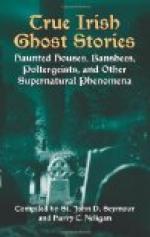“Thank Heavens, it’s gone!”
“What was it?” asked the Count.
“Nothing human,” replied the Colonel—“nothing belonging to this world. It was a woman of no earthly type, with a queer-shaped, gleaming face, a mass of red hair, and eyes that would have been beautiful but for their expression, which was hellish. She had on a green hood, after the fashion of an Irish peasant.”
An American lady present suggested that the description tallied with that of the Banshee, upon which the Count said:
“I am an O’Neill—at least I am descended from one. My family name is, as you know, Neilsini, which, little more than a century ago, was O’Neill. My great-grandfather served in the Irish Brigade, and on its dissolution at the time of the French Revolution had the good fortune to escape the general massacre of officers, and in company with an O’Brien and a Maguire fled across the frontier and settled in Italy. On his death his son, who had been born in Italy, and was far more Italian than Irish, changed his name to Neilsini, by which name the family has been known ever since. But for all that we are Irish.”
“The Banshee was yours, then!” ejaculated the Colonel. “What exactly does it mean?”
“It means,” the Count replied solemnly, “the death of some one very nearly associated with me. Pray Heaven it is not my wife or daughter.”
On that score, however, his anxiety was speedily removed, for within two hours he was seized with a violent attack of angina pectoris, and died before morning.[11]
[Footnote 11: Occult Review for September, 1913.]
Mr. Elliott O’Donnell, to whose article on “Banshees” we are indebted for the above, adds: “The Banshee never manifests itself to the person whose death it is prognosticating. Other people may see or hear it, but the fated one never, so that when everyone present is aware of it but one, the fate of that one may be regarded as pretty well certain.”
We must now pass on from the subject of Banshees to the kindred one of “Headless Coaches,” the belief in which is widespread through the country. Apparently these dread vehicles must be distinguished from the phantom coaches, of which numerous circumstantial tales are also told. The first are harbingers of death, and in this connection are very often attached to certain families; the latter appear to be spectral phenomena pure and simple, whose appearance does not necessarily portend evil or death.
“At a house in Co. Limerick,” writes Mr. T.J. Westropp, “occurred the remarkably-attested apparition of the headless coach in June 1806, when Mr. Ralph Westropp, my great-grandfather, lay dying. The story was told by his sons, John, William, and Ralph, to their respective children, who told it to me. They had sent for the doctor, and were awaiting his arrival in the dusk. As they sat on the steps they suddenly heard a heavy rumbling, and saw a huge




